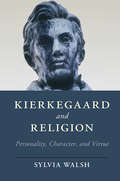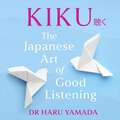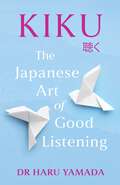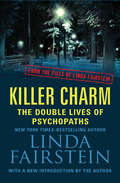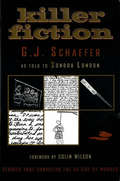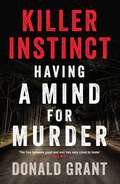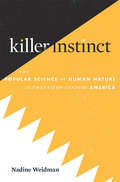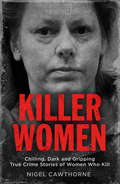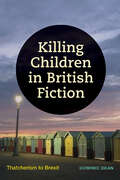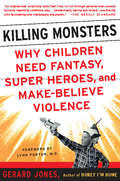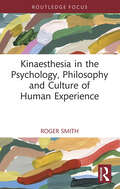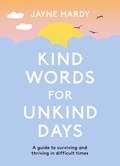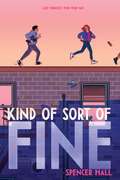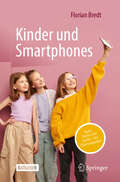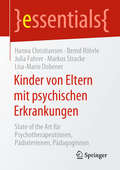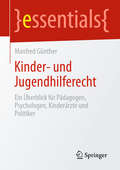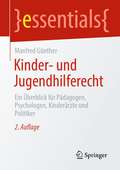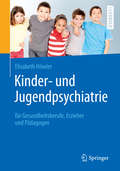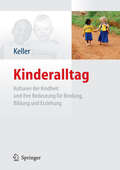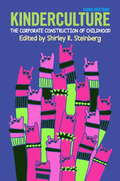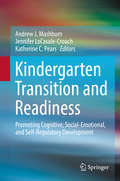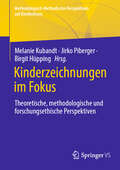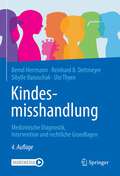- Table View
- List View
Kierkegaard and Religion: Personality, Character, And Virtue (Cambridge Studies In Religion, Philosophy And Society )
by Sylvia WalshNo thinker has reflected more deeply on the role of religion in human life than Søren Kierkegaard, who produced in little more than a decade an astonishing number of works devoted to an analysis of the kind of personality, character, and spiritual qualities needed to become an authentic human being or self. <p><p>Understanding religion to consist essentially as an inward, passionate, personal relation to God or the eternal, Kierkegaard depicts the art of living religiously as a self through the creation of a kaleidoscope of poetic figures who exemplify the constituents of selfhood or the lack thereof. The present study seeks to bring Kierkegaard into conversation with contemporary empirical psychology and virtue ethics, highlighting spiritual dimensions of human existence in his thought that are inaccessible to empirical measurement, as well as challenging on religious grounds the claim that he is a virtue ethicist in continuity with the classical and medieval virtue tradition.<p> Explores and clarifies the concepts of personality, character, and virtue in Kierkegaard's thought.<p> Elucidates the dialectic of jest and earnestness, human agency and divine agency, human striving and grace in Kierkegaard's thought.<p> Relates Kierkegaard's concepts of personality, character, and virtue to alternative approaches in contemporary philosophy, theology, and empirical psychology.
Kierkegaard and the Problem of Self-Love
by John LippittThe problem of whether we should love ourselves – and if so how – has particular resonance within Christian thought and is an important yet underinvestigated theme in the writings of Søren Kierkegaard. In Works of Love, Kierkegaard argues that the friendships and romantic relationships which we typically treasure most are often merely disguised forms of 'selfish' self-love. Yet in this nuanced and subtle account, John Lippitt shows that Kierkegaard also provides valuable resources for responding to the challenge of how we can love ourselves, as well as others. Lippitt relates what it means to love oneself properly to such topics as love of God and neighbour, friendship, romantic love, self-denial and self-sacrifice, trust, hope and forgiveness. The book engages in detail with Works of Love, related Kierkegaard texts and important recent studies, and also addresses a wealth of wider literature in ethics, moral psychology and philosophy of religion.
Kiku: The Japanese Art of Good Listening
by Haru YamadaListening connects us to others and the world around us. Learn how to harness its power in this life-changing new book.Drawing on the Japanese concept of 'kiku', sociolinguist and listening expert Haru Yamada shares a transformational guide to becoming better listeners in our daily life. Kiku is a particular type of listening that goes beyond the superficial. It is a deep listening that brings us together.Kiku offers a brand-new insight into the art of listening and an informative roadmap to help you to listen with intention and meaning in your daily interactions. Once you understand how hearing and listening work, you'll start noticing your own. You will gain a deeper understanding of the world. You'll read rooms better because you'll be reading more deeply between the lines of the people around you. Kiku is an essential guide to unlocking the power of listening in your relationships, at work and at home, and in the wider world around you.
Kiku: The Japanese Art of Good Listening
by Haru YamadaListening connects us to others and the world around us. Learn how to harness its power in this life-changing new book.Drawing on the Japanese concept of 'kiku', sociolinguist and listening expert Haru Yamada shares a transformational guide to becoming better listeners in our daily life. Kiku is a particular type of listening that goes beyond the superficial. It is a deep listening that brings us together.Kiku offers a brand-new insight into the art of listening and an informative roadmap to help you to listen with intention and meaning in your daily interactions. Once you understand how hearing and listening work, you'll start noticing your own. You will gain a deeper understanding of the world. You'll read rooms better because you'll be reading more deeply between the lines of the people around you. Kiku is an essential guide to unlocking the power of listening in your relationships, at work and at home, and in the wider world around you.
Killer Charm: The Double Lives of Psychopaths (From the Files of Linda Fairstein #1)
by Linda FairsteinLinda Fairstein unmasks the true face of psychopathy, and reveals the warning signs that every woman should knowThe 2009 &“Craigslist Killer&” murder case shocked America, not just because of the heinous nature of the crimes but because their perpetrator—a handsome young law student with an unsuspecting girlfriend—seemed a very unlikely suspect. This killer, like others before him, had learned to leverage his charm and golden-boy looks to lure his victims, a skill many psychopaths learn to master. In Killer Charm, legal expert Linda Fairstein draws on her decades of experience in the Manhattan District Attorney&’s office to uncover what traits psychopaths often share, and how to spot them. She illustrates these points with the stories of some of America&’s most notorious sex criminals, such as Ted Bundy and Marvin Teicher. Originally published in Cosmopolitan, this essay is now available in digital format for the first time and features a new introduction by the author.
Killer Fiction
by Colin Wilson G. J. Schaefer Sondra LondonIncluding a foreword by a woman who once dated him, the perverse, violent stories, poetry, and fantastic scribblings of a man convicted in 1972 of murdering two women chart the killer's extreme pathology.
Killer Instinct: Having a mind for murder
by Donald GrantForensic psychiatrist Donald Grant asks, what is it about murder that fascinates us? Is it the chill whisper of fear reminding us we too can kill? Grant describes ten true murder cases, each with unique triggers. For most of us, murder is an arm's length experience, close enough to frighten and fascinate yet far enough not to traumatise. For those directly affected, murder can be scarring. Our restless chatter about murder, our state of heightened alert, our endless appetite for news, may all just be play therapy, reassuring us that our own killer instincts are under control.
Killer Instinct: The Popular Science of Human Nature in Twentieth-Century America
by Nadine WeidmanA historian of science examines key public debates about the fundamental nature of humans to ask why a polarized discourse about nature versus nurture became so entrenched in the popular sciences of animal and human behavior. Are humans innately aggressive or innately cooperative? In the 1960s, bestselling books enthralled American readers with the startling claim that humans possessed an instinct for violence inherited from primate ancestors. Critics responded that humans were inherently loving and altruistic. The resulting debate—fiercely contested and highly public—left a lasting impression on the popular science discourse surrounding what it means to be human. Killer Instinct traces how Konrad Lorenz, Robert Ardrey, and their followers drew on the sciences of animal behavior and paleoanthropology to argue that the aggression instinct drove human evolutionary progress. Their message, spread throughout popular media, brought pointed ripostes. Led by the anthropologist Ashley Montagu, opponents presented a rival vision of human nature, equally based in biological evidence, that humans possessed inborn drives toward love and cooperation. Over the course of the debate, however, each side accused the other of holding an extremist position: that behavior was either determined entirely by genes or shaped solely by environment. Nadine Weidman shows that what started as a dispute over the innate tendencies of animals and humans transformed into an opposition between nature and nurture. This polarized formulation proved powerful. When E. O. Wilson introduced his sociobiology in 1975, he tried to rise above the oppositional terms of the aggression debate. But the controversy over Wilson’s work—led by critics like the feminist biologist Ruth Hubbard—was ultimately absorbed back into the nature-versus-nurture formulation. Killer Instinct explores what happens and what gets lost when polemics dominate discussions of the science of human nature.
Killer Women: Chilling, Dark and Gripping True Crime Stories of Women Who Kill
by Nigel CawthorneThe Chilling Inside Story of Women Who Are Driven to Kill Killer Women are the most disturbing yet compelling of all criminals, representing the very darkest side of humanity and subverting the conventional view of women as the weaker sex. From Elizabeth Bathory, 'The Bloody Countess' whose vampire-like tendencies terrorised sixteenth-century Hungary, to the Moors Murderer Myra Hindley and the Florida Highway Killer Aileen Wuornos, these women transfix us with their extreme ability to commit savage acts of cruelty and depravity. Most chilling is the fact that many of their victims represent the most vulnerable in society: babies, the ill and infirm, and the elderly. In some cases their methods of disposing of the corpses fall nothing short of ingenious: meet Leonarda Cianciulli, 'The Soap-Maker of Correggio', who used the fat from her victims' bodies to make soap and teacakes to sell to unsuspecting customers. These killers' backgrounds, methods and their crimes are described in forensic and gripping detail.50 terrifying cases of killer women are brought to life, including:Elizabeth Bathory 'The Bloody Countess'Amelia Dyer, The Reading Baby FarmerJane Toppan, 'Jolly Jane'Juana Barraza, The Old Lady KillerLeonarda Cianciulli, 'The Soap-Maker of Correggio'Bonnie Parker, 'Bonnie & Clyde'Rosemary WestMyra HindleyAileen Wuornos
Killer Women: Chilling, Dark and Gripping True Crime Stories of Women Who Kill
by Nigel CawthorneThe Chilling Inside Story of Women Who Are Driven to Kill Killer Women are the most disturbing yet compelling of all criminals, representing the very darkest side of humanity and subverting the conventional view of women as the weaker sex. From Elizabeth Bathory, 'The Bloody Countess' whose vampire-like tendencies terrorised sixteenth-century Hungary, to the Moors Murderer Myra Hindley and the Florida Highway Killer Aileen Wuornos, these women transfix us with their extreme ability to commit savage acts of cruelty and depravity. Most chilling is the fact that many of their victims represent the most vulnerable in society: babies, the ill and infirm, and the elderly. In some cases their methods of disposing of the corpses fall nothing short of ingenious: meet Leonarda Cianciulli, 'The Soap-Maker of Correggio', who used the fat from her victims' bodies to make soap and teacakes to sell to unsuspecting customers. These killers' backgrounds, methods and their crimes are described in forensic and gripping detail.50 terrifying cases of killer women are brought to life, including:Elizabeth Bathory 'The Bloody Countess'Amelia Dyer, The Reading Baby FarmerJane Toppan, 'Jolly Jane'Juana Barraza, The Old Lady KillerLeonarda Cianciulli, 'The Soap-Maker of Correggio'Bonnie Parker, 'Bonnie & Clyde'Rosemary WestMyra HindleyAileen Wuornos
Killing Children in British Fiction: Thatcherism to Brexit
by Dominic DeanThis book stems from a simple yet disturbing observation: contemporary British fiction is full of children killing or being killed. Thoughtfully considering novels and films, alongside actual murder cases and moral panics, Dominic Dean develops this insight into a complex account of British cultural history, from the Thatcher to Brexit eras. Killing Children in British Fiction argues that the figure of the child provides means for negotiating, and hence for understanding, recent crises in Britain and their intersections with broader transnational conflicts. The book explores works from major British authors such as Kazuo Ishiguro, Ian McEwan, Doris Lessing, Sarah Waters, Alan Hollinghurst, and Peter Ackroyd; emerging writers such as David Szalay and Melissa Harrison; and filmmakers, including Stanley Kubrick, Nicholas Roeg, Robin Hardy, Derek Jarman, and Remi Weekes. Bridging and often challenging existing scholarship in childhood studies, literary studies, psychoanalysis, and critical and queer theory, Dean shows how the child, at once materially present and representative of an insecure future, can provoke relentless fantasies, fears, and, most troublingly, acts of real violence by adults.
Killing Monsters: Why Children Need Fantasy, Super Heroes, and Make-Believe Violence
by Gerard JonesChildren choose their heroes more carefully than we think. From Pokémon to the rapper Eminem, pop-culture icons are not simply commercial pied pipers who practice mass hypnosis on our youth. Indeed, argues the author of this lively and persuasive paean to the power of popular culture, even trashy or violent entertainment gives children something they need, something that can help both boys and girls develop in a healthy way. Drawing on a wealth of true stories, many gleaned from the fascinating workshops he conducts, and basing his claims on extensive research, including interviews with psychologists and educators, Gerard Jones explains why validating our children's fantasies teaches them to trust their own emotions and build stronger selves.
Kinaesthesia in the Psychology, Philosophy and Culture of Human Experience
by Roger SmithThis accessible book explores the nature and importance of kinaesthesia, considering how action, agency and movement intertwine and are fundamental in feeling embodied in the world. Bringing together psychological, philosophical and cultural perspectives, the book examines the subjective feeling of movement in a cross-disciplinary manner. It discusses kinaesthesia through the framework of embodied cognition and outlines how contemporary discussion in psychology and phenomenology can inform our understanding of everyday experience. The book also sketches a framework for full appreciation of the sense of movement in performance and cultural life, discussing how a sense of movement is central to one’s agency. It is composed in four ‘movements’, aiming to achieve a connected and original argument for why movement matters, an argument exemplified in dance. The first movement explains the science of kinaesthesia and the history of the concept to a discussion of current thought informed by phenomenology and embodied cognition, the second quiet movement reflects on the psychological and philosophical dimensions of the sense of movement, the third movement turns to the culture of movement in dance and walking, and the fourth rests with the pleasures of movement, and emphasizes the social dimensions of movement in gesture and agency. This wide-ranging book is a must-read for all those interested in the psychology of movement, embodied cognition, performance studies and the interaction between psychology and dance. It will also be of interest to students and practitioners of embodied movement and dance practice therapies.
Kind Words for Unkind Days: A Guide To Surviving And Thriving In Difficult Times
by Jayne HardyA practical pick-me-up for life’s tough days, this book is the perfect guide to help you feel happier, healthier and calmer.
Kind of Sort of Fine
by Spencer HallSenior year changes everything for two teens in this poignant, funny coming-of-age story that looks at what happens when the image everyone has of us no longer matches who we really are.Senior year of high school is full of changes. For Hayley Mills, these changes aren&’t exactly welcome. All she wants is for everyone to forget about her very public breakdown and remember her as the overachiever she once was—and who she&’s determined to be again. But it&’s difficult to be seen as a go-getter when she&’s forced into TV Production class with all the slackers like Lewis Holbrook. For Lewis, though, this is going to be his year. After a summer spent binging 80s movies, he&’s ready to upgrade from the role of self-described fat, funny sidekick to leading man of his own life—including getting the girl. The only thing standing in his way is, well, himself. When the two are partnered up in class, neither is particularly thrilled. But then they start making mini documentaries about their classmates&’ hidden talents, and suddenly Hayley is getting attention for something other than her breakdown, and Lewis isn&’t just a background character anymore. It seems like they&’re both finally getting what they want—except what happens when who you&’ve become isn&’t who you really are?
Kinder und Smartphones: Apps, Stress und Sucht – ein Elternratgeber
by Florian BredtSmartphones bestimmen unser Leben und damit auch das der Kinder und Jugendlichen. Handys sind nützlich, sorgen aber auch für Stress. Sie können psychische Erkrankungen auslösen – bis hin zur Sucht. Dieser Ratgeber bietet Eltern und Erziehenden einen Überblick über Nutzen und Risiken des Smartphonegebrauchs und zeigt auf, wie Kinder und Heranwachsende angemessen mit dem Mobiltelefon umgehen können. Der Sozialpädagoge und Kinder- und Jugendlichenpsychotherapeut Florian Bredt gibt fundierte Ratschläge, die auf aktuellen Studien beruhen. Themen sind u.a. Cybermobbing, Smartphonesucht und welche Unterstützungsmöglichkeiten und Therapien hier zur Verfügung stehen. Arbeitsblätter zur Medienkompetenz und zum Handygebrauch ergänzen den verständlichen Elternratgeber.
Kinder von Eltern mit psychischen Erkrankungen: State of the Art für Psychotherapeutinnen, Pädiaterinnen, Pädagoginnen (essentials)
by Hanna Christiansen Bernd Röhrle Julia Fahrer Markus Stracke Lisa-Marie DobenerPsychische Erkrankungen sind häufig. Weltweit leben ca. 25 % aller Kinder mit einem psychisch erkrankten Elternteil zusammen. Diese Kinder haben ein erhöhtes Risiko, psychische Störungen zu entwickeln und stellen so eine besondere Risikogruppe dar. Gleichzeitig gibt es für diese Zielgruppe kaum präventive Interventionsangebote. Zudem sind Studien selten, die die Mechanismen und Interventionsmöglichkeiten im Zusammenhang mit der transgenerationalen Transmission psychischer Störungen untersuchen. Das Buch fasst den aktuellen Stand der Forschung zu dem Thema prägnant zusammen und stellt ausgewählte Forschungsprogramme zur verbesserten Versorgung betroffener Familien vor sowie aktuelle Präventionsansätze.
Kinder- und Jugendhilferecht: Ein Überblick für Pädagogen, Psychologen, Kinderärzte und Politiker (essentials)
by Manfred GüntherDer Autor stellt den komplexen Themenbereich Kinder- und Jugendrecht mit dem SGB VIII im Mittelpunkt übersichtlich und kompakt vor. Analysen und Kommentierung sind durchweg praxisfokussiert. Er verzichtet weitgehend auf Juristendeutsch und auf Paragrafenzitate. So erhalten die Leser*innen – sorgeberechtigte Eltern, andere Erziehungsberechtigte, Sozialpädagog*innen in Einrichtungen, Studierende, interessierte junge Menschen und nicht zuletzt die engagierten Jugendhilfe-„Lobbyist*innen“ in den Ausschüssen – einen schnellen, profunden Überblick über die wesentlichen politik- und praxisrelevanten Positionen über Angebote und Leistungen des gesamten deutschen Kinder- und Jugendhilferechts.
Kinder- und Jugendhilferecht: Ein Überblick für Pädagogen, Psychologen, Kinderärzte und Politiker (essentials)
by Manfred GüntherUnter Berücksichtigung des KJSG von Juni 2021 stellt der Autor das Kinder- und Jugendrecht mit dem SGB VIII im Mittelpunkt übersichtlich und kompakt vor. Analysen und Kommentierung erscheinen durchweg aktuell und verständlich, denn er verzichtet weitestgehend aufs Juristendeutsch. So erhalten die Leser*innen – sorgeberechtigte Eltern, andere Erziehungsberechtigte, betroffene junge Menschen, Sozialpädagog*innen in Einrichtungen, Studierende – und nicht zuletzt die engagierten „Lobbyist*innen“ in den Jugendhilfeausschüssen – einen schnellen, profunden Überblick über die wesentlichen politik- und praxisrelevanten Positionen; im Fokus stehen die Rechtsansprüche: Angebote, Leistungen sowie wichtige und nützliche Allgemeine Vorschriften des deutschen Sozialgesetzbuchs Kinder- und Jugendhilfe.
Kinder- und Jugendpsychiatrie für Gesundheitsberufe, Erzieher und Pädagogen
by Elisabeth HöwlerDieses Buch richtet sich an alle Erzieher, Pädagogen, Ergotherapeuten, Logopäden, Physiotherapeuten und Pflegende, die mit Kindern und Jugendlichen mit psychischen Störungen arbeiten. Die erfahrene Autorin beschreibt die häufigsten Krankheitsbilder anhand von zahlreichen Fallbeispielen und gibt für den professionellen Umgang mit den Betroffenen hilfreiche Praxistipps. So lernen Sie, wie Sie bei Ihrer therapeutischen und pädagogischen Arbeit u.a. die psychische Gesundheit von Kindern und Jugendlichen fördern können.
Kinderalltag
by Heidi KellerDie Kindheit wird von kulturellen Mustern geprägt. Nur wenn diese unterschiedlichen Muster akzeptiert werden, kann Integration gelingen. Heidi Keller und ihr Team haben zwei grundlegende, im ersten Lebensjahr angelegte Muster identifiziert und diese Erkenntnisse verständlich und praxisnah aufbereitet. Ziel der Autoren ist es, Kinderpsychotherapeuten, Kindergärtnerinnen, Erzieherinnen und Eltern für die eigene, kulturell geprägte Wahrnehmung sowie die Akzeptanz anderer kultureller Praktiken als gleichberechtigte Lebensformen zu sensibilisieren.
Kinderculture
by Shirley R. SteinbergAmerica is a corporatized society defined by a culture of consumerism, and the youth market is one of the groups that corporations target most. By marketing directly to children, through television, movies, radio, video games, toys, books, and fast food, advertisers have produced a "kinderculture. ” In this eye-opening book, editor Shirley R. Steinberg reveals the profound impact that our purchasing-obsessed culture has on our children and argues that the experience of childhood has been reshaped into something that is prefabricated. Analyzing the pervasive influence of these corporate productions, top experts in the fields of education, sociology, communications, and cultural studies contribute incisive essays that students, parents, educators, and general readers will find insightful and entertaining. Including seven new chapters, this third edition is thoroughly updated with examinations of the icons that shape the values and consciousness of today’s children, including Twilight, True Blood, and vampires, hip hop, Hannah Montana, Disney, and others.
Kindergarten Transition and Readiness: Promoting Cognitive, Social-Emotional, and Self-Regulatory Development
by Andrew J. Mashburn Jennifer LoCasale-Crouch Katherine C. PearsThis book presents a comprehensive overview of children’s transitions to kindergarten as well as proven strategies that promote their readiness. It presents theories and research to help understand children’s development during the early childhood years. It describes evidence-based interventions that support children in developmental areas essential to school success, including cognitive, social-emotional, and self-regulatory skills. Chapters review prekindergarten readiness programs designed to promote continuity of learning in anticipation of the higher grades and discuss transitional concerns of special populations, such as non-native speakers, children with visual and other disabilities, and children with common temperamental issues. The volume concludes with examples of larger-scale systemic approaches to supporting children’s development during the transition to kindergarten, describing a coherent system of early childhood education that promotes long-term development. Featured topics include:Consistency in children’s classroom experiences and implications for early childhood development.Changes in school readiness in U.S. kindergarteners.Effective transitions to kindergarten for low-income children.The transition into kindergarten for English language learners.The role of close teacher-child relationships during the transition into kindergarten.Children’s temperament and its effect on their kindergarten transitions.Kindergarten Transition and Readiness is a must-have resource for researchers, clinicians and related professionals, and graduate students in child and school psychology, educational psychology, social work, special education, and early childhood education.
Kinderzeichnungen im Fokus: Theoretische, methodologische und forschungsethische Perspektiven (Methodologisch-Methodische Perspektiven auf Kindheit(en))
by Birgit Hüpping Melanie Kubandt Jirko PibergerDie erziehungswissenschaftliche Debatte um Kinderzeichnung nimmt seit einigen Jahren erneut Fahrt auf, vor allem mit Blick auf die Möglichkeiten und Herausforderungen ihres forschungspraktischen Einsatzes und der methodisch kontrollierten Interpretation. Die Autor*innen sind Mitglieder eines DFG-geförderten Forschungsnetzwerkes „Methodologisch-methodische Zugänge zu Kinderzeichnungen&“, dessen Arbeitsergebnisse in diesem Band zusammengetragen werden. Dabei kommen vielfältige Zugriffsmöglichkeiten auf und Einsatzmöglichkeiten von Kinderzeichnungen zur Geltung. Ein abschließendes Resümee versucht die unterschiedlichen Stränge zu verweben, verweist jedoch zugleich auf lose Fäden und zeigt bestehende Forschungsdesiderate auf.
Kindesmisshandlung: Medizinische Diagnostik, Intervention und rechtliche Grundlagen
by Bernd Herrmann Reinhard B. Dettmeyer Sibylle Banaschak Ute ThyenDas bewährte Fachbuch zum Kinderschutz in der Medizin bietet Strategien für den Umgang mit Verdachtsfällen von Kindesmisshandlung und -vernachlässigung, fundierte fachliche Grundlagen für die Diagnose, Sicherheit in Rechtsfragen und erprobte Konzepte für die Intervention. Fundierte somatische Diagnostik Leitliniengerecht, hohe EvidenzRationale diagnostische StrategienForensische BefundsicherungKinder- und jugendgynäkologische Grundlagen Umsichtige Intervention & Prävention Gesprächsführung mit Eltern, Kindern und JugendlichenInterdisziplinäre Netzwerke schaffen und nutzenFrühe Hilfen und KinderschutzSchutzkonzepte für den Umgang mit Missbrauch in Institutionen Gesellschaftliche und rechtliche Grundlagen Auszüge wichtigster GesetzeGesetzlicher Opferschutz, psychosoziale Folgen Kompakt und praxisrelevant Korrekte Anamnese und DokumentationMerkblätter, Checklisten, InternetadressenPraxistipps, Differenzialdiagnosen und Fallstricke Vom „unguten Gefühl“ zu evidenzbasiertem Handeln. Unter Berücksichtigung der aktuellen Literatur, Gesetze und Rechtsprechung sowie der neuen nationalen AWMF S3+ Kinderschutzleitlinie und internationaler Leitlinien. Das erste deutschsprachige Handbuch für fachgerechte medizinische Diagnostik und Intervention. Das notwendige „Handwerkszeug“ für Ärzte und andere Gesundheitsberufe, um in der täglichen Praxis die richtigen Entscheidungen zu treffen. Als bewährter Leitfaden, Ratgeber und Nachschlagewerk für Ärzte, aber auch alle anderen beteiligten Fachleute im Kinderschutz: Juristen, Polizei, Jugendämter, Beratungsstellen. Mit allen relevanten Inhalten für Basis- und Aufbaukurs des Zertifikatslehrganges Kinderschutzmedizin der Deutschen Gesellschaft für Kinderschutz in der Medizin (DGKiM).Mit eLernkarten „Flashcards“ zur Vorbereitung auf die Zertifikatsprüfung Kinderschutzmedizin der DGKiM.
